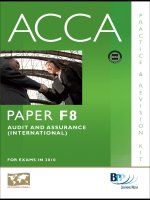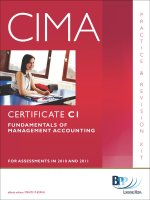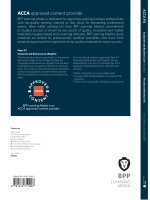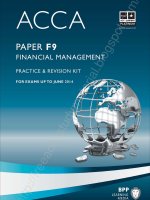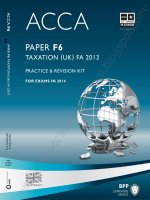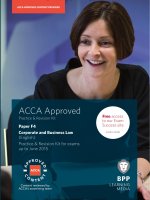CIMA c1 BPP REVISION KIT
Bạn đang xem bản rút gọn của tài liệu. Xem và tải ngay bản đầy đủ của tài liệu tại đây (4.17 MB, 313 trang )
QUESTIONS
Certificate Paper C1
FUNDAMENTALS OF
MANAGEMENT ACCOUNTING
For assessments in 2010 and 2011
Practice & Revision Kit
In this December 2009 edition
• Banks of multiple choice questions and objective test questions on every
syllabus area
• Answers with detailed feedback
• Two mock assessments
• Fully up to date as at 1 December 2009
BPP Learning Media's i-Pass product also supports this paper
First edition June 2006
Third edition December 2009
A note about copyright
Dear Customer
ISBN 9780 7517 8073 4
(previous 9780 7517 5180 2)
What does the little © mean and why does it matter?
British Library Cataloguing-in-Publication Data
A catalogue record for this book
is available from the British Library
Your market-leading BPP books, course materials and
e-learning materials do not write and update themselves. People write
them: on their own behalf or as employees of an organisation that
invests in this activity. Copyright law protects their livelihoods. It
does so by creating rights over the use of the content.
Published by
BPP Learning Media Ltd
BPP House, Aldine Place
London W12 8AA
With current technology, things might seem a bit hazy but, basically,
without the express permission of BPP Learning Media:
www.bpp.com/learningmedia
•
Photocopying our materials is a breach of copyright
Printed in the United Kingdom
•
Scanning, ripcasting or conversion of our digital materials into
different file formats, uploading them to facebook or emailing
them to your friends is a breach of copyright
Your learning materials, published by BPP Learning Media
Ltd, are printed on paper sourced from sustainable, managed
forests.
You can, of course, sell your books, in the form in which you have
bought them – once you have finished with them. (Is this fair to your
fellow students? We update for a reason.) But the e-products are sold
on a single user licence basis: we do not supply ‘unlock’ codes to
people who have bought them second-hand.
All our rights reserved. No part of this publication may be
reproduced, stored in a retrieval system or transmitted, in any
form or by any means, electronic, mechanical, photocopying,
recording or otherwise, without the prior written permission
of BPP Learning Media Ltd.
We are grateful to the Chartered Institute of Management
Accountants for permission to reproduce past examination
questions. The answers to past examination questions have
been prepared by BPP Learning Media Ltd.
©
BPP Learning Media Ltd
2009
ii
Breach of copyright is a form of theft – as well as being a criminal
offence in some jurisdictions, it is potentially a serious breach of
professional ethics.
And what about outside the UK? BPP Learning Media strives to make
our materials available at prices students can afford by local printing
arrangements, pricing policies and partnerships which are clearly
listed on our website. A tiny minority ignore this and indulge in
criminal activity by illegally photocopying our material or supporting
organisations that do. If they act illegally and unethically in one area,
can you really trust them?
Contents
Page
Revision
Revising with this Kit ....................................................................................................................................................... iv
Effective revision.............................................................................................................................................................. vi
The assessment
Assessment technique ..................................................................................................................................................... ix
Tackling multiple choice questions.................................................................................................................................. xi
Tackling objective test questions .................................................................................................................................... xii
Background
Current issues................................................................................................................................................................ xiv
Useful websites.............................................................................................................................................................. xiv
Question and answer checklist/index ....................................................................................................... xv
Questions
Answers
Question practice
Objective test questions .................................................................................................................................... 3 ...................125
Assessment practice
Mock assessment 1 ...................................................................................................................................... 235 ...................251
Mock assessment 2 ...................................................................................................................................... 263 ...................281
Review form & free prize draw
iii
Revising with this Kit
Have you worked through the
Paper C1 Study Text and do you feel ready
to start practice and revision?
YES
NO
Read 'Effective revision'
(page vi).
Go back through
your notes and try some of
the questions in the Study
Text again.
Read 'Tackling multiple
choice questions'
(page xi).
Read 'Tackling objective
test questions'
(page xii).
You might find it useful
to read the relevant
section of the Paper C1
Passcards before you
answer questions on a
particular topic.
Attempt a couple of
sets of MCQs and OTs in each
subject area.
Go back through
your notes and/or look through the
Paper C1 Passcards.
Did you get the majority of the
questions correct?
YES
Attempt the remaining
MCQs and OTs in each area.
Answer all questions.
iv
Introduction
NO
Were you happy with your performance on
the questions?
NO
YES
Have another go at the
questions with which you
had problems.
Read ‘Assessment
technique’
(page ix).
Do the two mock assessments
on pages 235 and 263.
Introduction
v
Effective revision
This guidance applies if you have been studying for an assessment over a period of time. (Some tuition providers
are teaching subjects by means of one intensive course that ends with the assessment.)
What you must remember
Time is very important as you approach the assessment. You must remember:
Believe in yourself
Use time sensibly
Believe in yourself
Are you cultivating the right attitude of mind? There is absolutely no reason why you should not pass this
assessment if you adopt the correct approach.
•
Be confident – you've passed exams before, you can pass them again
•
Be calm – plenty of adrenaline but no panicking
•
Be focused – commit yourself to passing the assessment
Use time sensibly
vi
1
How much study time do you have? Remember that you must eat, sleep, and of course, relax.
2
How will you split that available time between each subject? A revision timetable, covering what and how
you will revise, will help you organise your revision thoroughly.
3
What is your learning style? AM/PM? Little and often/long sessions? Evenings/ weekends?
4
Do you have quality study time? Unplug the phone. Let everybody know that you're studying and shouldn't
be disturbed.
5
Are you taking regular breaks? Most people absorb more if they do not attempt to study for long
uninterrupted periods of time. A five minute break every hour (to make coffee, watch the news headlines)
can make all the difference.
6
Are you rewarding yourself for your hard work? Are you leading a healthy lifestyle?
Introduction
What to revise
Key topics
You need to spend most time on, and practise lots of questions on, topics that are likely to yield plenty of
questions in your assessment.
You may also find certain areas of the syllabus difficult.
Difficult areas are
•
•
•
Areas you find dull or pointless
Subjects you highlighted as difficult when you studied them
Topics that gave you problems when you answered questions or reviewed the material
DON’T become depressed about these areas; instead do something about them.
•
Build up your knowledge by quick tests such as the quick quizzes in your BPP Learning Media Study Text
and the batches of questions in the i-Pass CD ROM.
•
Work carefully through examples and questions in the Text, and refer back to the Text if you struggle with
questions in the Kit.
Breadth of revision
Make sure your revision covers all areas of the syllabus. Your assessment will test your knowledge of the whole
syllabus.
How to revise
There are four main ways that you can revise a topic area.
Write it!
Read it!
Teach it!
Do it!
Write it!
Writing important points down will help you recall them, particularly if your notes are presented in a way that makes
it easy for you to remember them.
Introduction
vii
Read it!
You should read your notes or BPP Learning Media Passcards actively, testing yourself by doing quick quizzes or
Kit questions while you are reading.
Teach it!
Assessments require you to show your understanding. Teaching what you are learning to another person helps you
practise explaining topics that you might be asked to define in your assessment. Teaching someone who will
challenge your understanding, someone for example who will be taking the same assessment as you, can be helpful
to both of you.
Do it!
Remember that you are revising in order to be able to answer questions in the assessment. Practising questions
will help you practise technique and discipline, which can be crucial in passing or failing assessments.
1
Start your question practice by doing a couple of sets of objective test questions in a subject area. Note
down the questions where you went wrong, try to identify why you made mistakes and go back to your
Study Text for guidance or practice.
2
The more questions you do, the more likely you are to pass the assessment. However if you do run short of
time:
3
•
Make sure that you have done at least some questions from every section of the syllabus
•
Look through the banks of questions and do questions on areas that you have found difficult or on
which you have made mistakes
When you think you can successfully answer questions on the whole syllabus, attempt the two mock
assessments at the end of the Kit. You will get the most benefit by sitting them under strict assessment
conditions, so that you gain experience of the vital assessment processes.
•
•
Managing your time
Producing answers
BPP Learning Media's Learning to Learn Accountancy gives further valuable advice on how to approach revision.
BPP Learning Media has also produced other vital revision aids.
•
Passcards – Provide you with clear topic summaries and assessment tips
•
i-Pass CDs – Offer you tests of knowledge to be completed against the clock
•
MCQ cards – Offer you practise in MCQs
You can purchase these products by visiting www.bpp.com/cima
viii
Introduction
Assessment technique
Format of the assessment
The assessment will contain 50 questions to be completed in 2 hours. The questions will be a combination of
multiple choice questions and other types of objective test questions.
Passing assessments
Passing assessments is half about having the knowledge, and half about doing yourself full justice in the
assessment. You must have the right approach to two things.
The day of the assessment
Your time in the assessment room
The day of the assessment
1
Set at least one alarm (or get an alarm call) for a morning assessment.
2
Have something to eat but beware of eating too much; you may feel sleepy if your system is digesting a
large meal.
3
Allow plenty of time to get to the assessment room; have your route worked out in advance and listen to
news bulletins to check for potential travel problems.
4
Don't forget pens and watch. Also make sure you remember entrance documentation and evidence of
identity.
5
Put new batteries into your calculator and take a spare set (or a spare calculator).
6
Avoid discussion about the assessment with other candidates outside the assessment room.
Your time in the assessment room
1
Listen carefully to the invigilator's instructions
Make sure you understand the formalities you have to complete.
2
Ensure you follow the instructions on the computer screen
In particular ensure that you select the correct assessment (not every student does!), and that you
understand how to work through the assessment and submit your answers.
Introduction
ix
3
Keep your eye on the time
In the assessment you will have to complete 50 questions in 120 minutes. That will mean that you have
roughly 2½ minutes on average to answer each question. You will be able to answer some questions
instantly, but others will require thinking about. If after a minute or so you have no idea how to tackle the
question, leave it and come back to it later.
4
Label your workings clearly with the question number
This will help you when you check your answers, or if you come back to a question that you are unsure
about.
5
Deal with problem questions
There are two ways of dealing with questions where you are unsure of the answer.
6
(a)
Don't submit an answer. The computer will tell you before you move to the next question that you
have not submitted an answer, and the question will be marked as not done on the list of questions.
The risk with this approach is that you run out of time before you do submit an answer.
(b)
Submit an answer. You can always come back and change the answer before you finish the
assessment or the time runs out. You should though make a note of answers that you are unsure
about, to ensure that you do revisit them later in the assessment.
Make sure you submit an answer for every question
When there are ten minutes left to go, concentrate on submitting answers for all the questions that you have
not answered up to that point. You won’t get penalised for wrong answers so take a guess if you're unsure.
7
Check your answers
If you finish the assessment with time to spare, check your answers before you sign out of the assessment.
In particular revisit questions that you are unsure about, and check that your answers are in the right format
and contain the correct number of words as appropriate.
BPP Learning Media's Learning to Learn Accountancy gives further valuable advice on how to approach the
day of the assessment.
x
Introduction
Tackling multiple choice questions
The MCQs in your assessment contain a number of possible answers. You have to choose the option(s) that best
answers the question. The three incorrect options are called distracters. There is a skill in answering MCQs quickly
and correctly. By practising MCQs you can develop this skill, giving you a better chance of passing the assessment.
You may wish to follow the approach outlined below, or you may prefer to adapt it.
Step 1
Note down how long you should allocate to each MCQ. For this paper you will be answering 50
questions in 120 minutes, so you will be spending on average just under two and a half minutes on
each question. Remember however that you will not be expected to spend an equal amount of time
on each MCQ; some can be answered instantly but others will take time to work out.
Step 2
Attempt each question. Read the question thoroughly.
You may find that you recognise a question when you sit the assessment. Be aware that the detail
and/or requirement may be different. If the question seems familiar read the requirement and options
carefully – do not assume that it is identical.
Step 3
Read the four options and see if one matches your own answer. Be careful with numerical questions,
as the distracters are designed to match answers that incorporate common errors. Check that your
calculation is correct. Have you followed the requirement exactly? Have you included every stage of a
calculation?
Step 4
You may find that none of the options matches your answer.
•
Re-read the question to ensure that you understand it and are answering the requirement
•
Eliminate any obviously wrong answers
•
Consider which of the remaining answers is the most likely to be correct and select the
option
Step 5
If you are still unsure, continue to the next question. Likewise if you are nowhere near working out
which option is correct after a couple of minutes, leave the question and come back to it later. Make
a note of any questions for which you have submitted answers, but you need to return to later. The
computer will list any questions for which you have not submitted answers.
Step 6
Revisit questions you are uncertain about. When you come back to a question after a break you
often find you are able to answer it correctly straight away. If you are still unsure have a guess. You
are not penalised for incorrect answers, so never leave a question unanswered!
Introduction
xi
Tackling objective test questions
What is an objective test question?
An objective test (OT) question is made up of some form of stimulus, usually a question, and a requirement to do
something.
•
MCQs. Read through the information on page (xi) about MCQs and how to tackle them.
•
True or false. You will be asked if a statement is true or false.
•
Data entry. This type of OT requires you to provide figures such as the correct figure for payables in a
statement of financial position, or words to fill in a blank.
•
Multiple response. These questions provide you with a number of options and you have to identify those
that fulfil certain criteria.
OT questions in your assessment
CIMA is currently developing different types of OTs for inclusion in computer-based assessments. The timetable for
introduction of new types of OTs is uncertain, and it is also not certain how many questions in your assessment will
be MCQs, and how many will be other types of OT. Practising all the different types of OTs that this Kit provides will
prepare you well for whatever questions come up in your assessment.
Dealing with OT questions
Again you may wish to follow the approach we suggest, or you may be prepared to adapt it.
Step 1
Work out how long you should allocate to each OT. Remember that you will not be expected to spend
an equal amount of time on each one; some can be answered instantly but others will take time to
work out.
Step 2
Attempt each question. Read the question thoroughly, and note in particular what the question says
about the format of your answer and whether there are any restrictions placed on it (for example the
number of words you can use).
You may find that you recognise a question when you sit the assessment. Be aware that the detail
and/or requirement may be different. If the question seems familiar read the requirement and options
carefully – do not assume that it is identical.
Step 3
xii
Introduction
Read any options you are given and select which ones are appropriate. Check that your calculations
are correct. Have you followed the requirement exactly? Have you included every stage of the
calculation?
Step 4
You may find that you are unsure of the answer.
•
Re-read the question to ensure that you understand it and are answering the requirement
•
Eliminate any obviously wrong options if you are given a number of options from which to
choose
Step 5
If you are still unsure, continue to the next question. Make a note of any questions for which you
have submitted answers, but you need to return to later. The computer will list any questions for
which you have not submitted answers.
Step 6
Revisit questions you are uncertain about. When you come back to a question after a break you often
find you are able to answer it correctly straight away. If you are still unsure have a guess. You are not
penalised for incorrect answers, so never leave a question unanswered!
Introduction
xiii
Current issues
Feedback from students
Feedback from students sitting the CBAs has highlighted the following:
•
•
•
•
•
A mix of £ and $ may be used
Sales tax may be referred to as VAT
Inventory may be referred to as stock
Receivables may be referred to as debtors
Payables may be referred to as creditors
Useful websites
The websites below provide additional sources of information of relevance to your studies for Fundamentals of
Management Accounting.
•
BPP
www.bpp.com
For details of other BPP material for your CIMA studies
•
CIMA
The official CIMA website
xiv
Introduction
www.cimaglobal.com
Question and Answer checklist/index
The headings in this checklist/index indicate the main topics of questions, but questions often cover several
different topics.
Page number
Question
Answer
Objective test questions
1
Introduction to management accounting and costing I
3
125
2
Introduction to management accounting and costing II
5
126
3
Cost behaviour
7
127
4
Overheads costs – absorption costing I
10
129
5
Overheads costs – absorption costing II
12
131
6
Overheads costs – absorption costing III
15
133
7
Overheads costs – absorption costing IV
16
135
8
Overheads costs – absorption costing V
19
137
9
Overhead costs – absorption costing VI
10 Marginal costing and pricing
21
139
24
142
11 Inventory valuation I
27
145
12 Inventory valuation II
29
147
13 Breakeven analysis and limiting factor analysis I
31
150
14 Breakeven analysis and limiting factor analysis II
33
152
15 Breakeven analysis and limiting factor analysis III
37
155
16 Breakeven analysis and limiting factor analysis IV
40
157
17 Standard costing
43
159
18 Variance analysis – material variances
46
161
19 Variance analysis – labour variances
49
164
20 Variance analysis – variable overhead variances
52
168
21 Variance analysis – sales variances
56
172
22 Variance analysis – interpretation
58
174
23 Budgeting I
61
176
24 Budgeting II
63
178
25 Budgeting III
66
180
26 Budgeting IV
68
182
27 Budgeting V
70
184
28 Budgeting VI
73
187
29 Budgeting VII
76
191
30 Budgeting VIII
79
194
31 Budgeting IX
82
197
32 Cost bookkeeping I
84
199
33 Cost bookkeeping II
87
201
34 Cost bookkeeping III
90
203
Introduction
xv
Objective test questions
35 Cost bookkeeping IV
92
205
36 Process costing I
95
207
37 Process costing II
98
210
38 Process costing III
101
216
39 Job, batch and contract costing I
103
218
40 Job, batch and contract costing II
105
220
41 Job, batch and contract costing III
108
223
42 Service costing
111
225
43 Mixed bank I
113
227
44 Mixed bank II
116
229
45 Mixed bank III
118
231
Mock assessment 1
Mock assessment 2
235
251
263
281
Mixed bank questions
xvi
Introduction
Objective test questions
1
2
1 Introduction to management accounting and costing I
1
A cost unit is
A
B
C
D
2
A cost centre is
A
B
C
D
3
4
(i)
(ii)
(iii)
Postage cost
Invoice processed
Supplier account
A
B
C
D
Item (i) only
Item (ii) only
Item (iii) only
Items (ii) and (iii) only
Prime cost is
all costs incurred in manufacturing a product
the total of direct costs
the material cost of a product
the cost of operating a department
Which of the following costs are part of the prime cost for a manufacturing company?
A
B
C
D
6
A unit of product or service in relation to which costs are ascertained
An amount of expenditure attributable to an activity
A production or service location, function, activity or item of equipment for which costs are accumulated
A centre for which an individual budget is drawn up
Which of the following items might be a suitable cost unit within the accounts payable department of a
company?
A
B
C
D
5
the cost per hour of operating a machine
the cost per unit of electricity consumed
a unit of product or service in relation to which costs are ascertained
a measure of work output in a standard hour
Cost of transporting raw materials from the supplier's premises
Wages of factory workers engaged in machine maintenance
Depreciation of lorries used for deliveries to customers
Cost of indirect production materials
Which of the following are direct expenses?
(i)
(ii)
(iii)
(iv)
The cost of special designs, drawing or layouts
The hire of tools or equipment for a particular job
Salesman's wages
Rent, rates and insurance of a factory
A
B
C
D
(i) and (ii)
(i) and (iii)
(i) and (iv)
(iii) and (iv)
Questions
3
7
8
Which of the following are indirect costs?
(i)
(ii)
(iii)
The depreciation of maintenance equipment
The overtime premium incurred at the specific request of a customer
The hire of a tool for a specific job
A
B
C
D
Item (i) only
Items (i) and (ii) only
Items (ii) and (iii) only
All of them
A company employs three drivers to deliver goods to its customers. The salaries paid to these drivers are:
A
B
C
D
a part of prime cost
a direct production expense
a production overhead
a selling and distribution overhead
The following information relates to questions 9 and 10
The overhead expenses of a company are coded using a five digit coding system, an extract from which is as follows:
Cost centre
Machining
Finishing
Packing
Stores
Maintenance
Code no
10
11
12
13
14
Types of expense
Indirect materials
Depreciation of production machinery
Indirect wages
Maintenance materials
Machine hire costs
Depreciation of non-production equipment
Code no
410
420
430
440
450
460
The coding for the hire costs of a packing machine is 12450
9
The coding for the depreciation of maintenance equipment is
A
B
C
D
10
The coding for the issue of indirect materials issued from stores to the machining department is
A
B
C
D
4
10460
14420
14440
14460
Questions
10410
10440
13410
13440
2 Introduction to management accounting and costing II
1
Gross wages incurred in department 1 in June were $54,000. The wages analysis shows the following
summary breakdown of the gross pay.
Paid to
Paid to
direct labour
indirect labour
$
$
Ordinary time
25,185
11,900
Overtime: basic pay
5,440
3,500
premium
1,360
875
Shift allowance
2,700
1,360
Sick pay
1,380
300
36,065
17,935
What is the direct wages cost for department 1 in June?
A
B
C
D
2
Which of the following would be classed as indirect labour?
A
B
C
D
3
$25,185
$30,625
$34,685
$36,065
A coach driver in a transport company
Machine operators in a milk bottling plant
A maintenance assistant in a factory maintenance department
Plumbers in a construction company
Which of the following item(s) might be a suitable cost unit within the credit control department of a
company?
Telephone expense
Cheque received and processed
Customer account
4
Which one of the following would be classed as indirect labour?
Machine operators in a company manufacturing washing machines
A stores assistant in a factory store
Plumbers in a construction company
A committee in a firm of management consultants
Questions
5
5
A company has to pay a $1 per unit royalty to the designer of a product which it manufactures and sells.
The royalty charge would be classified in the company's accounts as a (tick the correct answer):
Direct expense
Production overhead
Administrative overhead
Selling overhead
6
Fixed costs are conventionally deemed to be (tick the correct answer):
Constant per unit of activity
Constant in total when activity changes
Outside the control of management
Unaffected by inflation
7
Which three of the following are ways in which indirect production costs can be incurred?
Service costs, for example, stores
Establishment costs, for example rent and rates
Production costs, for example, supervisors' salaries
Prime costs, for example, materials
8
Depreciation on production equipment is (tick all answers that are correct):
Not a cash cost
Part of production overheads
Part of prime cost
Always calculated using a machine-hour rate
9
A manufacturing firm has temporary production problems and overtime is being worked.
The amount of overtime premium contained in direct wages would normally be classed as which one of the
following:
Direct expenses
Production overheads
Direct labour costs
Administrative overheads
6
Questions
10
The following information is available for product Zed for the month of January.
Production costs:
Variable
Fixed
$8 per unit
$12,000
The total production cost of producing 8,000 units of product Zed in January is $
.
3 Cost behaviour
1
Variable costs are conventionally deemed to
A
B
C
D
2
be constant per unit of output
vary per unit of output as production volume changes
be constant in total when production volume changes
vary, in total, from period to period when production is constant
The following is a graph of cost against level of activity
To which one of the following costs does the graph correspond?
A
B
C
D
Electricity bills made up of a standing charge and a variable charge
Bonus payment to employees when production reaches a certain level
Salesman's commissions payable per unit up to a maximum amount of commission
Bulk discounts on purchases, the discount being given on all units purchased
Questions
7
The following information relates to questions 3 to 5
$
Total
cost
$
Total
Cost
Level of activity
Graph 2
Graph 1
Total
cost
$
Total
cost
$
Level of activity
Graph 3
Graph 4
Level of activity
Which one of the above graphs depicts the costs described in questions 3 to 5?
3
Photocopier rental costs, where a fixed rental is payable up to a certain number of copies each period. If the
number of copies exceeds this amount, a constant charge per copy is made for all subsequent copies during
that period.
A
B
C
D
4
Supervisor salary costs, where one supervisor is needed for every five employees added to the staff.
A
B
C
D
5
Graph 1
Graph 2
Graph 3
Graph 4
Vehicle hire costs, where a constant rate is charged per mile travelled, up to a maximum monthly payment
regardless of the miles travelled.
A
B
C
D
8
Graph 1
Graph 2
Graph 3
Graph 4
Questions
Graph 1
Graph 2
Graph 3
Graph 4
